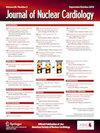使用当代三维心脏模拟 PET-CT 成像技术,快速与慢速铷-82 输注曲线以及心肌灌注的测试-重复精度。
IF 3
4区 医学
Q2 CARDIAC & CARDIOVASCULAR SYSTEMS
引用次数: 0
摘要
背景:在使用 50 mL/min Rb-82 配置文件的传统二维 PET 系统上,定量灌注的测试-重复精度为 10%。目前还不清楚在现代模拟三维 PET-CT 系统上,Rb-82 输注率是否会显著影响定量灌注和/或图像质量。我们的目的是确定在现代模拟三维 PET-CT 扫描仪上,Rb-82 输注曲线是否会对定量灌注的测试-重复精度、灌注指标和/或图像质量产生重大影响:来自 3 个不同群体的 98 名志愿者:健康志愿者(正常人)、有危险因素和/或冠状动脉疾病的患者(临床人)和既往有经壁心肌梗死的患者(梗死人),在模拟三维 PET-CT 上进行了心脏负荷测试。参与者连续接受 3 次静息扫描和 2 次应激扫描,每次扫描间隔几分钟,并随机分配两种 Rb-82 输注曲线:50毫升/分钟(快速[F])和20毫升/分钟(慢速[S])。使用 HeartSee 软件计算灌注指标(静息(rMBF)和应激心肌血流(sMBF))。结果:rMBF 在快速和慢速剖面之间具有良好的相关性,类内相关系数 (ICC) 为 0.91-0.93。sMBF 在快速和慢速剖面之间具有高度相关性(ICC=0.97)。快速和慢速曲线具有相似的同日重复测试精度(COV 11.5% vs. 11.3% (p=0.77);RC 21.5% vs. 22.6%,F-F vs. S-S)。F 型和 S 型的 MBF 值没有明显的临床差异。两种剖面的图像质量指标相似:结论:使用现代模拟三维 PET-CT 进行 Rb-82 快速和慢速输注,在精确度、灌注指标或图像质量方面没有明显的临床差异。本文章由计算机程序翻译,如有差异,请以英文原文为准。
Fast vs slow rubidium-82 infusion profiles and test-retest precision of myocardial perfusion using contemporary 3D cardiac analog positron emission tomography-computed tomography imaging
Background
On legacy 2D positron emission tomography (PET) systems utilizing a 50 mL/min Rb-82 profile, test-retest precision of quantitative perfusion is ∼10%. It is unclear whether Rb-82 infusion rate significantly impacts quantitative perfusion and/or image quality on modern analog 3D PET-CT systems. We aimed to determine whether the Rb-82 infusion profile significantly impacts test-retest precision of quantitative perfusion, perfusion metrics, and/or image quality on a modern analog 3D PET-CT scanner.
Methods
Ninety-eight volunteers from 3 distinct groups: healthy volunteers (Normals), patients with risk factors, and/or coronary disease (Clinicals) and patients with prior transmural myocardial infarctions (Infarcts), underwent cardiac stress testing on an analog 3D PET-CT. Participants received 3 consecutive resting scans and 2 consecutive stress scans, minutes apart, with two randomly assigned Rb-82 infusion profiles: 50 mL/min (fast [F]) and 20 mL/min (slow [S]). Perfusion metrics (resting (rMBF) and stress myocardial blood flow (sMBF)) were calculated using HeartSee software. Coefficients of variance (COV), repeatability (RC), MBF, and image quality metrics were compared.
Results
rMBF correlated well between F and S profiles, with intraclass correlation coefficients (ICC) ranging .91-.93. sMBF was highly correlated between F and S profiles (ICC = .97). Fast and slow profiles were associated with similar same-day test-retest precision (COV 11.5% vs 11.3% (P = .77); RC 21.5% vs 22.6%, for F–F vs S–S). There were no clinically significant differences in MBF values between F and S profiles. Image quality metrics were similar between the 2 profiles.
Conclusions
There are no clinically significant differences in precision, perfusion metrics, or image quality between Rb-82 fast and slow infusions using a contemporary analog 3D PET-CT.
求助全文
通过发布文献求助,成功后即可免费获取论文全文。
去求助
来源期刊
CiteScore
5.30
自引率
20.80%
发文量
249
审稿时长
4-8 weeks
期刊介绍:
Journal of Nuclear Cardiology is the only journal in the world devoted to this dynamic and growing subspecialty. Physicians and technologists value the Journal not only for its peer-reviewed articles, but also for its timely discussions about the current and future role of nuclear cardiology. Original articles address all aspects of nuclear cardiology, including interpretation, diagnosis, imaging equipment, and use of radiopharmaceuticals. As the official publication of the American Society of Nuclear Cardiology, the Journal also brings readers the latest information emerging from the Society''s task forces and publishes guidelines and position papers as they are adopted.

 求助内容:
求助内容: 应助结果提醒方式:
应助结果提醒方式:


